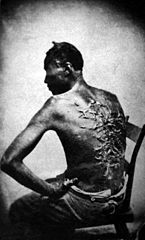Difference between revisions of "Dehumanization"
m |
|||
| (2 intermediate revisions by one other user not shown) | |||
| Line 15: | Line 15: | ||
Shortly after Japan's attack on Pearl Harbor, President Roosevelt ordered the internment of over 100,000 people of Japanese ancestry. One Wyoming camp was described as "a barbed-wire-surrounded enclave with unpartitioned toilets, cots for beds, and a budget of 45 cents daily per capita for food rations." The proliferation of anti-Japanese propaganda fueled a fear mongering campaign that largely justified the internment in the minds of the civilian population. | Shortly after Japan's attack on Pearl Harbor, President Roosevelt ordered the internment of over 100,000 people of Japanese ancestry. One Wyoming camp was described as "a barbed-wire-surrounded enclave with unpartitioned toilets, cots for beds, and a budget of 45 cents daily per capita for food rations." The proliferation of anti-Japanese propaganda fueled a fear mongering campaign that largely justified the internment in the minds of the civilian population. | ||
| − | ==== | + | ==== Linked patterns==== |
[[Cultural imperialism]], [[Criminalizing Poverty]], [[Racism]], [[Silenced Voices]], [[Xenophobia]] | [[Cultural imperialism]], [[Criminalizing Poverty]], [[Racism]], [[Silenced Voices]], [[Xenophobia]] | ||
| + | ====Rererences==== | ||
| − | + | <references/> | |
| − | + | ||
Latest revision as of 16:53, 26 February 2014
Description
One of the best ways to exploit and mistreat a population is to distance oneself from them as much as possible. We can justify our actions against others by portraying our enemies as sub-human monsters that deserve less that ethical treatment. By creating rigid us/them boundaries we can effectively establish that "we" are in the right, and "they" are dead wrong.
How it Works
Dehumanization is an effective method of controlling the populace. The target group will suffer psychologically and become accustomed to the maltreatment, and the conformist population will have an enemy that is easy to hate and blame problems on. By continually treating and portraying subsets of people who aren't in line with the goals of the state as less than human, that representation will eventually permeate the minds of the rest of the population. As the rest of the population adopts the dehumanizing attitude, they will naturally treat the target peoples with malice. This will serve to reinforce the aims of the state and will create an institutionalized oppression.
Evidence
Treatment of slaves in America was generally brutal, degrading, and inhumane. About 25% of colonial Americans owned slaves, but because slave labor was considerably cheaper than hired labor, nearly all of the white population benefited from slavery in some way. Slave labor as well as slave trade factored heavily into the economies of all colonies. Even most of those who were morally against slavery participated indirectly because it made financial sense. 200 years after abolition racist attitudes towards African Americans persist.
During colonial times and through the westward expansion across America, Native Americans were referred to and considered savages. The term savages was used specifically to help foster an attitude toward them as being less than human, which aided in justifying the slaughter of many, and relegating the rest to reservations.
Shortly after Japan's attack on Pearl Harbor, President Roosevelt ordered the internment of over 100,000 people of Japanese ancestry. One Wyoming camp was described as "a barbed-wire-surrounded enclave with unpartitioned toilets, cots for beds, and a budget of 45 cents daily per capita for food rations." The proliferation of anti-Japanese propaganda fueled a fear mongering campaign that largely justified the internment in the minds of the civilian population.
Linked patterns
Cultural imperialism, Criminalizing Poverty, Racism, Silenced Voices, Xenophobia

